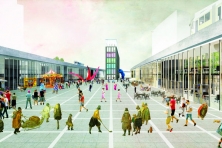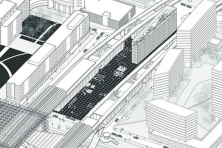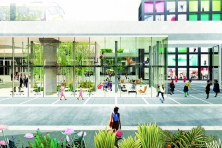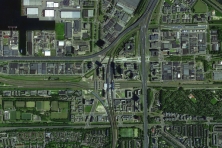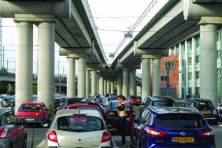Undergrowth
Amsterdam Piarcoplein (NL) - Lauréat
DONNÉES DE L’ÉQUIPE
Représentante d’équipe: Federica Andreini (IT) – architecte
Associés: Mattia Biagi (IT), Annachiari Bonora (IT), Valeria Lollobattista (IT), Marco Mondello (IT), Valerio Socciarelli (IT) – architectes
info@gnomone.com - gnomone.com
Voir la liste complète des portraits ici
Voir la page du site en anglais ici

V. Socciarelli, A. Bonora, F. Andreini, V. Lollobattista, M. Biagi et M. Mondello
INTERVIEW en anglais
Cliquer sur les images pour les agrandir
1. How did you form the team for the competition?
We have been working together since 2013, starting from the first competition that we won and achieved (the installation for Demanio Marittimo KM278 in Marzocca, Italy). Since then, Gnomone, the name of our group, works together in a flexible conformation. In fact, depending on the occasion, our working group is composed of all or of a portion of us. Nonetheless, the esteem and the trust we place in Gnomone is such that we still feel like always represented. For this edition of Europan, every member of Gnomone participated in the design team.
2. How do you define the main issue of your project, and how did you answer on this session main topic: the place of productive activities within the city?
The area already has plenty of parks and other vaguer open spaces. In this situation, and since the very beginning, we thought that it was strategic to typologically think about the future Piarcoplein as a square, in order to carry out the topic of productive city. This way, it will be able to better receive all the systems arriving there, both ecological and transport, and to foster vibration, affluence and proximity within the neighbourhood. A square is, above all, a precise answer to the demands inherent in the theme of rethinking the productive city. Historically, it is a hybrid space that offers itself as support for different aspects of city life. Since a square is naturally characterized by compresence and proximity of activities, it can interpret and give space to a new idea of production, more circular and diffused.
3. How did this issue and the questions raised by the site mutation meet?
Without any nostalgic attitude, we learn from historical cities that lively squares need to be mainly mineral, enclosed and precisely defined by continuous and active borders. For this reason, erecting new volumes is a necessary operation in Piarcoplein. Proportions of the buildings are also crucial for the scale of the square, since the dimensions of the existing constructions are too aloof to dialogue with the groundscape.
4. Have you treated this issue previously? What were the reference projects that inspired yours?
To a certain extent, we always think about architecture within its urban context, so we always try to understand the relation between our projects and the site where they are implanted. This way, although the program is a square, a garden, a little installation or a building, we try to dialogue with the surroundings and to spread the influence of the project to a wider area. To inform the project, we consider images and engravings relating to urban spaces, as well as Renaissance perspectives: we find interesting that such an emblematic space of today's city has, in latency, formal, proportional and functional relationships with classical urban environments.
5. Urban-architectural projects like the ones in Europan can only be implemented together with the actors through a negotiated process and in time. How did you consider this issue in your project?
The project consists of some heavy but concentrated actions, in order to recreate the edges and define an urban space that is legible, simple and therefore habitable according to variable times and uses. Those important characters are mainly the definition and the proportion of the open space, so we believe that any eventual formal changes would be able to be absorbed, without losing the core sense of the project.
6. Is it the first time you have been awarded a prize at Europan? How could this help you in your professional career?
Some of us (Annachiara Bonora, Valeria Lollobattista, Mattia Biagi and Valerio Socciarelli) already participated to Europan competition during the 13th edition, being awarded with a runner-up prize. It was a great opportunity to meet other architects in an international environment, to share ideas with the municipality and to strengthen our own collaboration.
